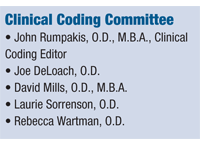I got a phone call the other day. It started off pretty much the same as many of the calls that I get:
“Hi John, I was hoping you could help me. I went to a coding seminar recently and the lecturer was telling me about all of the things I should be billing for that I’m not. The lecturer said that incorporating the ‘medical model’ in an optometric practice is just like printing money. The lecturer said that any time I do a test, the only thing I need is a medical diagnosis or even a symptom like blurry vision or headaches, and then anything I do with that patient is billable to a medical carrier. Is this right? Am I missing out on a significant source of income? Should I be testing the heck out of every patient just because he or she has a symptom like blurry vision?”
At this point in the conversation, alarm bells are going off in my head and red flags are popping up in my vision.
Look, I’m the first to state that by incorporating full-scope eye care into your practice and getting paid for it is a great practice builder.
But—and it’s a big but—increasing your income from providing medical eye care in your practice is simply a by-product of providing the standard of care to your patients and coding correctly from what is written into your medical record.
One should never be putting patient economics above patient care.
Remember the Basics
Let’s review a few basic principles:
• Establish medical necessity. You must always establish the medical necessity for any test or procedure in the medical record. Keep in mind that the ICD-9 rules, which we are bound to follow according to HIPAA, clearly state that the only time that one can use the patient’s symptoms as a diagnosis is in the absence of making a diagnosis––so just because the patient has blurry vision doesn’t mean that you can automatically order visual fields, scanning laser ophthalmoscopy or a fundus photo.
• Chief complaint drives the encounter. The chief complaint is what drives the encounter and establishes who the responsible party is for billing and payment. So, just because a patient has high blood pressure and they’re in your office to get a new supply of contact lenses, that doesn’t mean that you can bill the medical carrier for the encounter.
• Charge the same fee for the same procedure. You must charge all parties the same fee for the same procedure. If you’re willing to bill a medical carrier for hundreds of dollars in ancillary tests/procedures, you must also be willing to bill an individual patient for the same amount. Having medical insurance is not an automatic green light to rack up large amounts of fees on behalf of your patient.
• Verify the information. Please, please, please—before you do anything in your practice suggested by any lecturer, get references for what they’re telling you, and make sure that you’re aware of the local laws, regulations, guidelines and policies that apply to you and your practice before actually doing anything.
No Such Thing as a ‘Quick Buck’
Medical eye care is certainly contributing a growing proportion to our bottom line; however, doing things correctly is more important than making a quick buck. Insurance audits, or “post-payment reviews,” are on the rise—a quick buck made because you thought that providing medical eye care was like printing money is easily taken back with other significant ramifications to your practice.
Maybe just one more final thought: We often don’t want to take the time to do things right, but we always find time to do them over. Medical eye care and proper billing procedures will add to your bottom line for sure, but make sure that you are in compliance and doing it for the right reasons. Your patients deserve that.

Please send your comments to
CodingAbstract@gmail.com.

